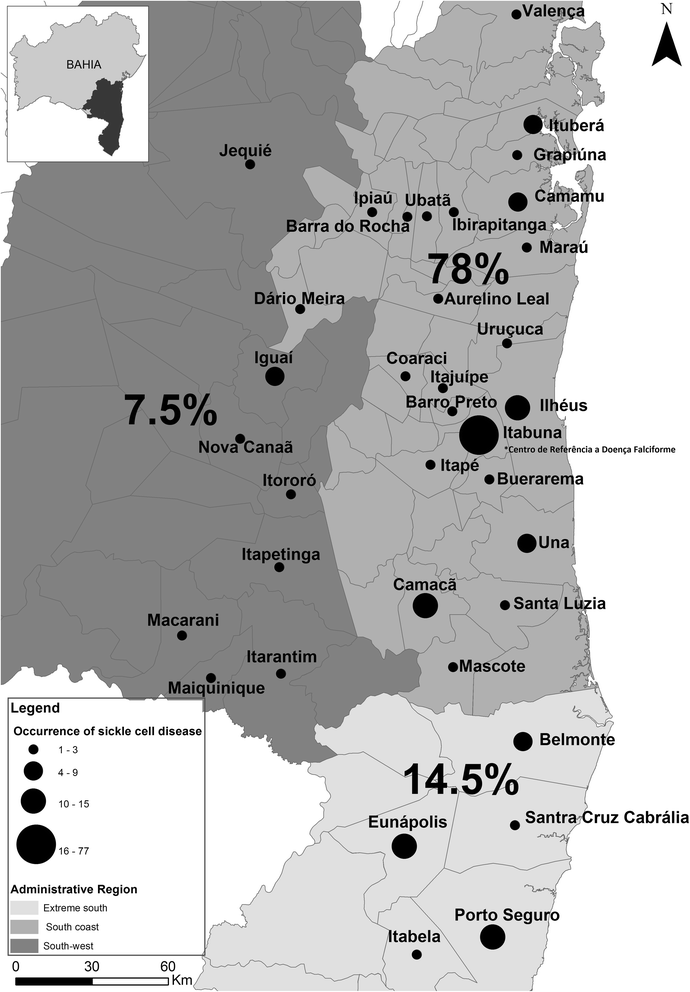Comparative study of sickle cell anemia and hemoglobin SC disease: clinical characterization, laboratory biomarkers and genetic profiles
- PMID: 28932402
- PMCID: PMC5602866
- DOI: 10.1186/s12878-017-0087-7
Comparative study of sickle cell anemia and hemoglobin SC disease: clinical characterization, laboratory biomarkers and genetic profiles
Abstract
Background: In this study, we evaluate the association of different clinical profiles, laboratory and genetic biomarkers in patients with sickle cell anemia (SCA) and hemoglobin SC disease (HbSC) in attempt to characterize the sickle cell disease (SCD) genotypes.
Methods: We conducted a cross-sectional study from 2013 to 2014 in 200 SCD individuals (141 with SCA; 59 with HbSC) and analyzed demographic data to characterize the study population. In addition, we determined the association of hematological, biochemical and genetic markers including the βS-globin gene haplotypes and the 3.7 Kb deletion of α-thalassemia (-α3.7Kb-thal), as well as the occurrence of clinical events in both SCD genotypes.
Results: Laboratory parameters showed a hemolytic profile associated with endothelial dysfunction in SCA individuals; however, the HbSC genotype was more associated with increased blood viscosity and inflammatory conditions. The BEN haplotype was the most frequently observed and was associated with elevated fetal hemoglobin (HbF) and low S hemoglobin (HbS). The -α3.7Kb-thal prevalence was 0.09 (9%), and it was associated with elevated hemoglobin and hematocrit concentrations. Clinical events were more frequent in SCA patients.
Conclusions: Our data emphasize the differences between SCA and HbSC patients based on laboratory parameters and the clinical and genetic profile of both genotypes.
Keywords: Biomarkers; Genetic profile; Hemoglobin SC disease; Sickle cell anemia.
Conflict of interest statement
Ethics approval and consent to participate
The study received approval from the institutional review board of Instituto Gonçalo Moniz at the Fundação Oswaldo Cruz (IGM-FIOCRUZ – Bahia - Brazil) (CAAE 08452913.9.0000.0040) and the informed consent was obtained from all the adults participants and children with consent of parents or guardians.
Consent for publication
Not applicable.
Competing interests
The authors declare that they have no competing interests.
Publisher’s Note
Springer Nature remains neutral with regard to jurisdictional claims in published maps and institutional affiliations.
Figures
Similar articles
-
Sickle cell disease: A distinction of two most frequent genotypes (HbSS and HbSC).PLoS One. 2020 Jan 29;15(1):e0228399. doi: 10.1371/journal.pone.0228399. eCollection 2020. PLoS One. 2020. PMID: 31995624 Free PMC article.
-
Association of classical markers and establishment of the dyslipidemic sub-phenotype of sickle cell anemia.Lipids Health Dis. 2017 Apr 11;16(1):74. doi: 10.1186/s12944-017-0454-1. Lipids Health Dis. 2017. PMID: 28399852 Free PMC article.
-
Polymorphisms in genes that affect the variation of lipid levels in a Brazilian pediatric population with sickle cell disease: rs662799 APOA5 and rs964184 ZPR1.Blood Cells Mol Dis. 2020 Feb;80:102376. doi: 10.1016/j.bcmd.2019.102376. Epub 2019 Oct 22. Blood Cells Mol Dis. 2020. PMID: 31670185
-
The influence of fetal hemoglobin on the clinical expression of sickle cell anemia.Ann N Y Acad Sci. 1989;565:262-78. doi: 10.1111/j.1749-6632.1989.tb24174.x. Ann N Y Acad Sci. 1989. PMID: 2476064 Review.
-
Chronic Pulmonary Complications of Sickle Cell Disease.Chest. 2016 May;149(5):1313-24. doi: 10.1016/j.chest.2015.11.016. Epub 2016 Jan 13. Chest. 2016. PMID: 26836905 Free PMC article. Review.
Cited by
-
Tripartite collaboration of blood-derived endothelial cells, next generation RNA sequencing and bioengineered vessel-chip may distinguish vasculopathy and thrombosis among sickle cell disease patients.Bioeng Transl Med. 2021 Jan 9;6(3):e10211. doi: 10.1002/btm2.10211. eCollection 2021 Sep. Bioeng Transl Med. 2021. PMID: 34589594 Free PMC article.
-
Osteonecrosis in sickle cell disease patients from Bahia, Brazil: a cross-sectional study.Int Orthop. 2018 Jul;42(7):1527-1534. doi: 10.1007/s00264-018-3905-z. Epub 2018 Mar 26. Int Orthop. 2018. PMID: 29582115
-
Review of Medication Therapy for the Prevention of Sickle Cell Crisis.P T. 2018 Jul;43(7):417-437. P T. 2018. PMID: 30013299 Free PMC article.
-
Sickle cell disease: A distinction of two most frequent genotypes (HbSS and HbSC).PLoS One. 2020 Jan 29;15(1):e0228399. doi: 10.1371/journal.pone.0228399. eCollection 2020. PLoS One. 2020. PMID: 31995624 Free PMC article.
-
Bone marrow necrosis and fat embolism syndrome: a dreadful complication of hemoglobin sickle cell disease.Autops Case Rep. 2017 Dec 8;7(4):42-50. doi: 10.4322/acr.2017.043. eCollection 2017 Oct-Dec. Autops Case Rep. 2017. PMID: 29259931 Free PMC article.
References
-
- WHO/AFRO. The health of the people: what works – the African Regional Health Report. Public health - organization and administration. 2014.
LinkOut - more resources
Full Text Sources
Other Literature Sources


